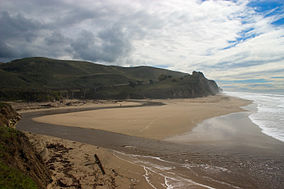San Gregorio State Beach: Difference between revisions
→External links: rm dead link |
→External links: rm dead link |
||
| Line 44: | Line 44: | ||
== External links == |
== External links == |
||
{{Commons category|San Gregorio State Beach}} |
{{Commons category|San Gregorio State Beach}} |
||
*[http://www.parks.ca.gov/default.asp?page_id=529 Official site from the California State Parks Department] |
|||
*[http://www.noehill.com/sanmateo/cal0026.asp Pictures of beach and plaque] |
*[http://www.noehill.com/sanmateo/cal0026.asp Pictures of beach and plaque] |
||
*[http://www.californiacoastline.org/cgi-bin/image.cgi?image=6225&mode=sequential&flags=0 Picture of the beach, creek, and highway from the California Coastal Records Project] |
*[http://www.californiacoastline.org/cgi-bin/image.cgi?image=6225&mode=sequential&flags=0 Picture of the beach, creek, and highway from the California Coastal Records Project] |
||
Revision as of 00:59, 19 August 2016
| San Gregorio State Beach | |
|---|---|
 | |
| Location | San Mateo County, California |
| Nearest city | San Gregorio |
| Governing body | California Department of Parks and Recreation |
San Gregorio State Beach is a beach near San Gregorio, California, USA, south of Half Moon Bay. Part of the California State Park System, the beach lies just west of the intersection of California State Route 1 and State Route 84.
Geography
San Gregorio Creek widens to form a small freshwater lagoon in the park behind a sand berm, or barrier beach, which typically blocks the mouth of the creek, forcing the creekwaters to flow underfoot as they seep into the Pacific Ocean. During the rainy season the creek often cuts through the sand berm and flows directly into the ocean. Historically the creek was a coho salmon spawning site, and the Department of Fish and Game is considering restocking it with coho to improve the salmon fisheries south of San Francisco.[1]
It is one of the cleanest in the state.[1]
Amenities
Park facilities include restrooms and picnic tables. Dogs are not permitted on the beach, as it has been identified as an itinerant nesting habitat for the locally underpopulated western snowy plover. North of the main beach is a nude beach (private property) that charges a fee to park in their parking lot north of the park's lot that provides closer access. It is considered a self-registered fee area, although there is a kiosk which is staffed during summer months.
Historical significance
A stone marker with a plaque (now missing) commemorates the three days Spanish explorer Gaspar de Portolà's expedition camped at the beach to rest and treat their sick in 1769, during their (failed) attempt to reach Monterey Bay. They would go on to discover San Francisco Bay instead.
The site is registered as California Historical Landmark 26.
See also
- California State Beaches
- Half Moon Bay State Beach, for further information on history and wildlife of the local area.
References
- ^ Bay Area beaches grade well for safe swimming, May 27, 2010 by Carolyn Jones, San Francisco Chronicle
